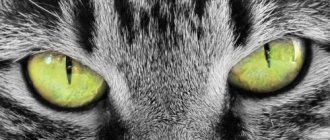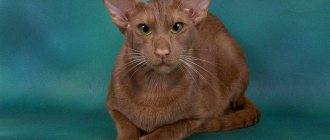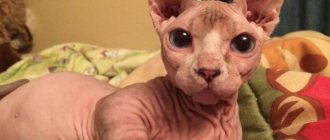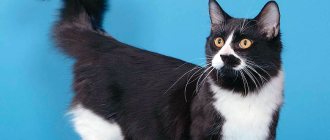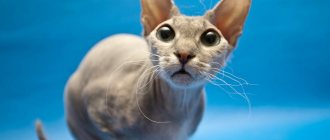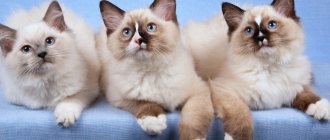Yoda
Fantastic cats with four ears have been mentioned in various sources for more than seventy years. The most famous representative of the “alien” species is Yoda the cat from Downers Grove, Illinois. It is so popular that its owners have collected an impressive collection of newspapers and magazines with publications about their favorite.
Yoda was born in the litter of a yard cat who worked as a rat catcher in a Chicago pub. When the cat brought the kittens, the pub staff didn't even notice that one of the babies was different from its brothers and sisters. The babies were put in a box and placed near the counter, hoping that at least some of the kittens could be accommodated.
Ted and Valerie recently lost their pet, who had lived with them for almost twenty years. They never thought about getting a new pet. But the tiny cat with four ears immediately won their hearts and insisted on moving into their home, climbing into Ted's arms and instantly falling asleep. At first, Valerie was worried about Yoda having an extra pair of ears, but the veterinarians assured her that the kitten was healthy. One of the doctors even turned to colleagues for help and began collecting information about this anomaly. It turned out that an adult cat with 4 ears lives in Germany, absolutely happy and full-fledged. The veterinarians' predictions came true: Yoda grew up to be a healthy and normal cat, and the extra ears did not bother him in any way.
Cat hearing
Hearing is an important tool for the soft-furred creature, allowing the animal to survive in the wild. The structure of cats' ears is different from human ears. These animals perceive many more sounds at the same time and can determine the distance to an object through hearing. Their ears have muscles that can move independently of each other, allowing animals to control their organs like locators, turn them in different directions and pick up any signals around them.
Luntya
But cats with four ears are not the most wonderful creatures. In Voronezh there lives a cat that has five ears, two on the left and three on the right! Vladimir, passing by the dining room, noticed something strange in the ears of a stray cat. From a distance it seemed to him that something was stuck there, but upon closer examination he realized that the yard muk was a carrier of a unique gene.
Luntya is not just a pet. She settled in the house of an associate professor of the Department of Anatomy, General Biology and Histology of the Faculty of Veterinary Medicine, and helps her owner research a genetic mutation. Vladimir Obryvkov does not keep Luntya in the laboratory and does not conduct terrible experiments on her - the cat lives in his apartment, a happy and well-fed life.
Vladimir Obryvkov says that a four-eared cat, like a five-eared one, is a carrier of a recessive gene, which manifests itself only if the litter is born from two homozygous or heterozygous individuals. That is, in order for a kitten with unusual ears to be born in a litter, both parents must carry this gene in explicit or hidden form. According to Vladimir, cats with extra ears are physically healthy and healthy; the extra ears are not fully formed, do not have ear canals and do not function in any way.
Another Luntik lives in Novocherkassk, but unlike Luntik from Voronezh, he has three pairs of ears! A cat with 4 ears lives in Rostov-on-Don. Some zoologists consider this mutation to be the result of a deteriorating environmental situation. Their opponents argue that all cat mutations - bare skin, floppy ears, long or curly hair, short legs or a stubby tail - are an ordinary “program glitch” that has nothing to do with external factors.
Normal or anomaly?
The first mention of four-eared pets can be found in 1938, when an article about an “alien” cat appeared in one of the American newspapers in the state of Ohio. At that time, she was recognized as one of a kind. But soon she gave birth to kittens that also carried the recessive gene for multiple ears.
Another 40 years later, again in America, but this time in the state of Tennessee (the city of Chattownooga), another unusual pet caused a sensation and excited the minds of cat lovers.
Research in this area began in 1957. The American Clarence Leatly worked closely on the issue. He found that in addition to the visually obvious anomaly, the cats also suffered from other unpleasant symptoms that accompanied the mutation:
- small size;
- slow development;
- malocclusion;
- frequent conjunctivitis, development of cataracts;
- peculiar shape of the skull;
- weak motor activity.
Moreover, the scientist suggested that the many-eared individuals were not particularly intelligent or developed intelligence.
The gene for four ears is recessive; the deviation can only appear if both parents carry hidden alleles.
Research by other scientists, as well as life experience and observations of not quite full-fledged pets did not always confirm Clarence’s theory - some animals were both quite smart and physically developed.
The presence of a second pair of ears does not mean that the pet hears twice as well.
- Most often, additional “locators” are simply shell-shaped flaps of skin that are in no way connected with the hearing organ.
- It also happens that both ears have one common auditory canal.
- And only in the rarest cases are both unilateral ears fully functional.
Wild pets
Cat enthusiasts are constantly experimenting with certain wild species that have a trait they are interested in. Therefore, cats with round ears are consistently in the field of view of breeders.
Serval
African predator, lives in the northern part of the continent. It reaches one and a half meters in length, 65 cm in height and weighs up to 20 kg. Rounded large ears and beautiful spotted colors traditionally attract the attention of breeders who are engaged in breeding new breeds.
These cats show distrust of humans, do not get along well and, no matter how much care they take, remain untamed for the rest of their lives. The exception is pets that came to people at an early age, but even after reaching puberty they dramatically change their behavior.
But the servals showed their best side in parenting qualities. They easily find a common language with ordinary domestic cats and have offspring with them. Some of these hybrids have become very popular.
Savannah
A hybrid of a serval and several domestic breeds. At various stages, Oriental, Bengal cats, Ocicat and Egyptian Mau took part in the selection. The result was a large animal that inherited from its wild ancestor its height (up to 60 cm), weight (15 kg), spotted predatory coloring and large ears with round tips. A very impressive and wayward cat.
Like other hybrids of wild animals, all offspring of the Savannah are marked by blood. F1 is a direct descendant from the first mating of an African cat (50% serval). In categories F1-F4, all cats remain sterile and cannot have offspring. Therefore, only females are suitable for further reproduction.
They are bred with domestic cats (usually the Bengal breed is chosen) and continue the savannah bloodline. The F5-F7 group is represented at home. She no longer has the hunting alertness and wild aggressiveness, but all the qualities of ordinary domestic cats are manifested.
Cat breeds with round ears
First of all, you should consider the known cat breeds in which the rounded tips of their ears were formed naturally.
Persian
This amazing cat is also called “Iranian”. The breed has three characteristic differences:
- Long hair is the pride of the breed and at the same time a headache for owners, since it is difficult to care for.
- Flattened muzzle and upturned nose.
- The Persian cat lacks the ability to adapt to living conditions outside the home.
Persians' ears are low, small, set wide apart, slightly rounded at the top.
Himalayan
The Himalayans continue the line of the Persians, they are a cross between long-haired Oriental and Siamese cats. From the first animals they took a luxurious long coat and a snub-nosed muzzle, and from the second they inherited the acromelanic color-point color.
The round ears of Himalayan cats exactly repeat the shape of the Persian branch and are no different from it.
Exotic
Another descendant of Iranian cats, but without long hair. Ordinary American cats were crossed with Persians and a new breed was obtained. It contains all the colors of the parent populations, there is a snub nose, a flattened muzzle and small ears with round tips.
American Curl
The list continues with a unique cat. Not only do her ears have an obvious roundness, but they are also bent in the opposite direction at an angle of 90°. A natural mutation was discovered in 1981 (USA). Later, the cat gave birth to seals with the same deformed round ears.
Another peculiarity is that babies are born with normal ears, but by the age of 4 months their round tips are completely curled up.
The American Curl comes in short and semi-long hair. The characteristic feature is preserved in two forms.
Elf
This very young breed was bred in 2006 from the Canadian Sphynx and the American Curl. The elf has a hairless, flexible body, wrinkled skin on the neck and head, slanted eyes and a flexible tail, pointed at the tip.
The portrait of an unusual cat is completed by large, backward-curved ears.
Oriental cats
The breed received recognition in 1977, although it appeared in Europe in the century before last, as evidenced by the entry in the Encyclopedia Britannica. For a long time there were disputes regarding the belonging of Orientals to the group of Siamese cats. They come from the same Asian region and are very similar in appearance.
There are only two significant differences:
- A color that does not have the “signature” Siamese color point.
- Large round ears - in an Oriental breed cat they are widely spaced and low set.
This is interesting! Many Oriental cats have a very loud and unpleasant voice. It is considered a distinctive feature of the breed.
Kinkaloe
Another cat from the galaxy of mestizos. The parent breeds were Munchkins (short-legged cats) and American Curls. The kinkalows inherited distinctive features from their ancestors. Kittens are born with normal ears, but after a week and a half, in some cats they begin to bend back, like those of Curls.
This is interesting! There are less than a hundred Kinkalows in the world, but in Russia there is already a specialized nursery where this unique breed is bred.
Highland Links
Round ears in cats are most often found in mixed breeds. Nature does not indulge pets with such traits, and breeders have taken on this function.
Highland is a hybrid of the desert lynx (caracal) and jungle curl. The latter generally has a mixture of several breeds - from swamp lynx to Bengals and Egyptian Mau, as well as an American Curl with round ears curved back.
The Highland Lynx is a large spotted cat with high paws, well-developed hocks (the hind legs are higher than the front legs), strong and active. Loyal to people.
It has a lynx face, a spotted coat, and a short tail. Due to the round shape of the ears, there are no “lynx” tassels, but even without them the animal is very similar to its wild ancestors.


